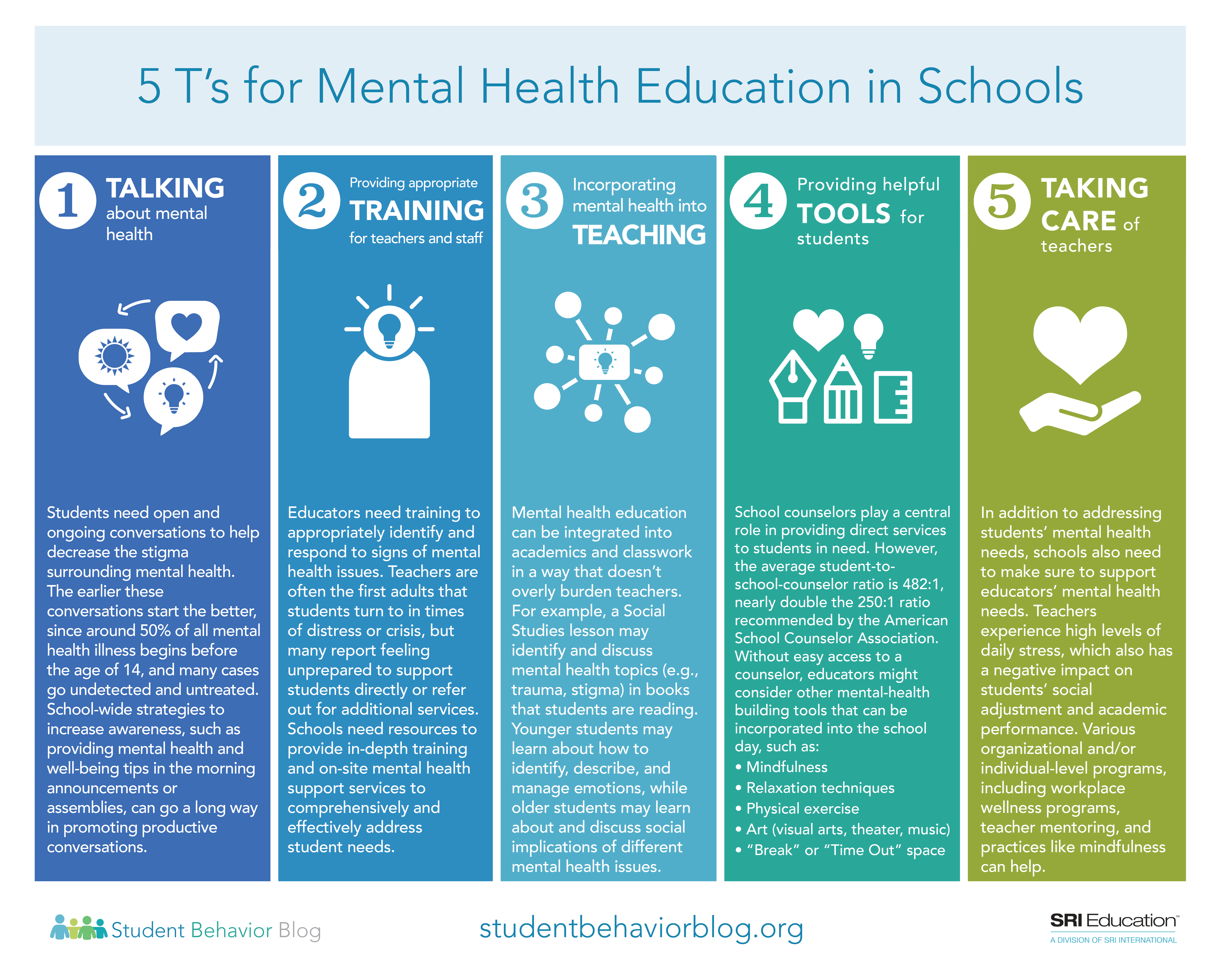Mental health is a critical part of students’ overall health and well-being.
Students today face a range of demands that can impact their mental health. From meeting high academic expectations to navigating the world of social media to maintaining relationships with their peers, students often have busy schedules that result in a lack of sleep and self-care. Many students are also dealing with distress, crises, and trauma in addition to typical life stressors. Mental health challenges can negatively impact all areas of functioning in students, contributing to social, emotional, behavioral, and academic problems.
Unfortunately, recent statistics indicate that student mental health is a prevalent and serious concern. According to a national survey, about 50% of youth between the ages of 13-18 experiences a mental health disorder at some point in their life. In addition, suicide is currently the second-leading cause of death for people ages 10-34 and during 1999-2016, suicide rates increased in nearly every state, including more than 30% increases in 25 states.
Schools have a unique and critical role to play in supporting student mental health and well-being in proactive, comprehensive, and collaborative ways. The just-released Advancing Comprehensive School Mental Health Systems report provides insight from national experts to help guide local, state, and national efforts in advancing comprehensive school mental health systems. While many schools are incorporating some aspect of mental health practices, currently only 3 states—Florida, New York, and Virginia—mandate mental health education for students (for grades 6-12 in Florida, K-12 in New York, and 9-10 in Virginia).
Mandated mental health curricula is one significant systematic step to address and improve student mental health and well-being at school, but what this actually looks like can vary greatly. We’ve identified 5 “T” strategies for states, districts, and schools to consider as their educators join the movement to promote and support student mental health:
| T Strategy | Why is this important? | Helpful resources |
|---|---|---|
| 1) TALKING about mental health | Students need open and ongoing conversations to help decrease the stigma surrounding mental health. The earlier these conversations start the better, since around 50% of all mental health illness begins before the age of 14, and many cases go undetected and untreated. School-wide strategies to increase awareness, such as providing mental health and well-being tips in the morning announcements or assemblies, can go a long way in promoting productive conversations. |
|
| 2) Providing appropriate TRAINING for teachers and staff | Educators need training to appropriately identify and respond to signs of mental health issues. Teachers are often the first adults that students turn to in times of distress or crisis, but many report feeling unprepared to support students directly or refer out for additional services. Schools need resources to provide in-depth training and on-site mental health support services to comprehensively and effectively address student needs. |
|
| 3) Incorporating mental health into TEACHING | Mental health education can be integrated into academics and classwork in a way that doesn’t overly burden teachers. For example, a Social Studies lesson may identify and discuss mental health topics (e.g., trauma, stigma) in books that students are reading. Younger students may learn about how to identify, describe, and manage emotions, while older students may learn about and discuss social implications of different mental health issues. |
|
| 4) Providing helpful TOOLS for students | School counselors play a central role in providing direct services to students in need. However, the average student-to-school-counselor ratio is 482:1, nearly double the 250:1 ratio recommended by the American School Counselor Association. Without easy access to a counselor, educators might consider other mental-health building tools that can be incorporated into the school day, such as:
|
|
| 5) TAKING CARE of teachers | In addition to addressing students’ mental health needs, schools also need to make sure to support educators’ mental health needs. Teachers experience high levels of daily stress, which also has a negative impact on students’ social adjustment and academic performance. Various organizational and/or individual-level programs, including workplace wellness programs, teacher mentoring, and practices like mindfulness can help. |
|
School is the ideal place for all types of learning to occur, including mental health education that aims to destigmatize mental health issues. Helping students and staff identify warning signs, having supportive conversations, and providing a range of tools and supports that promote overall health and well-being are all important strategies. Want to learn even more about ways to support student mental health? Check out the resources below!
Other Relevant Resources
- Advancing Comprehensive School Mental Health Systems report: Guidance from the Field provides insight from national experts to help guide local, state, and national efforts to strengthen school mental health efforts and to start to understand and bring consensus to the quality domains of school mental health. (Source: National Center for School Mental Health, NCSMH)
- A Guide to Campus Mental Health Action Planning provides mental health and suicide prevention strategies for teens and resources for student help-seeking behaviors. (Source: The Jed Foundation, TJF, and the Education Development Center, Inc, EDC)
- Toolkit for Mental Health Promotion and Suicide Prevention provides information for K-12 schools to promote student emotional and mental health and prevent suicide. It also discusses promotion of mental health and wellness, intervention in a suicidal crisis, and postvention response to a suicidal death. (Source: Heard Alliance)
- The Executive Summary of Aspen Institute’s Report, From a Nation at Risk to a Nation at Hope includes recommendations from the National Commission on Social, Emotional, & Academic Development on how to promote children’s social, emotional, and cognitive development in schools and communities. (Source: The Aspen Institute)
- Substance Use Prevention: A Resource Guide for School Staff provides teachers, principals, and other school staff with a comprehensive approach to identifying, addressing, and reducing student drug use. (Source: The Office of National Drug Control Policy, ONDCP)
Topics: Externalizing behaviors Internalizing behaviors Mental health Social-emotional learning

